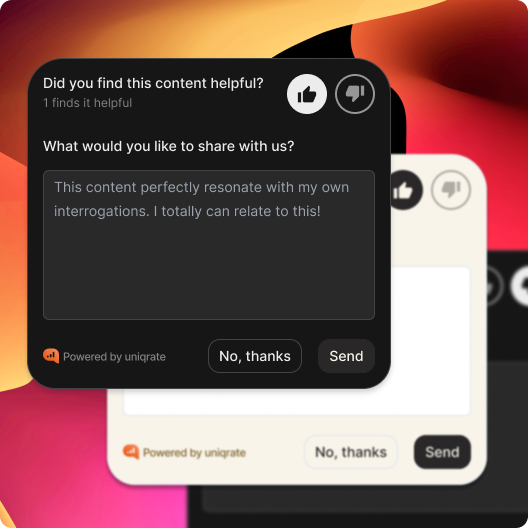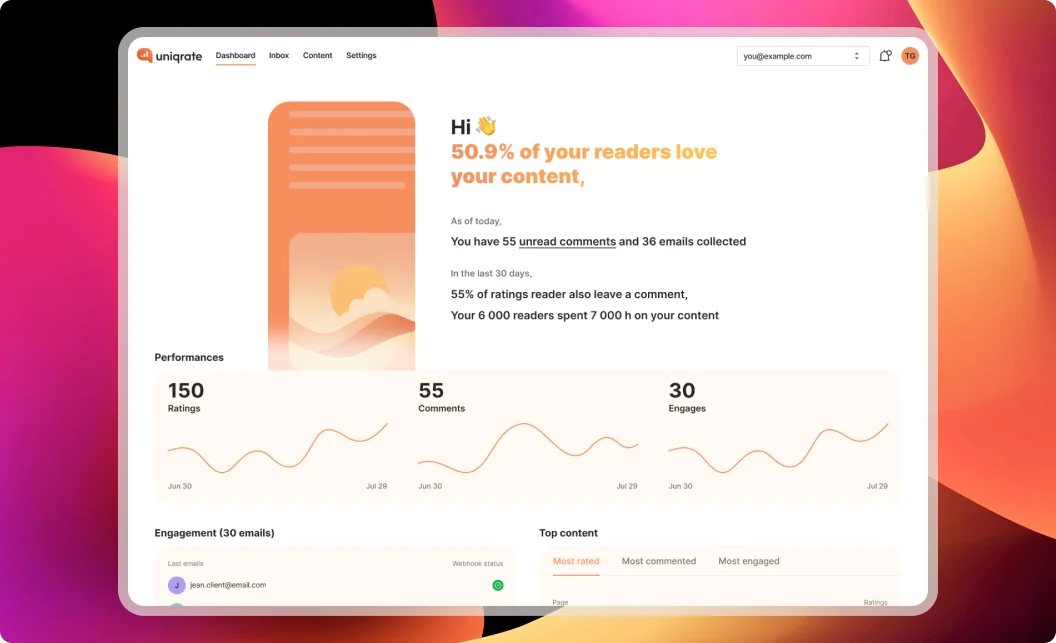In today’s competitive digital landscape, blogs are no longer just tools for sharing ideas or building an audience. For businesses, they’re crucial components of sales and marketing strategies. Yet, many bloggers and technical writers overlook one of the most effective ways to turn a blog into a revenue-generating asset: collecting and leveraging reader feedback.
Feedback provides invaluable insights into what your audience wants, how they interact with your content, and what changes can drive better engagement, conversions, and ultimately, sales. In this article, we’ll explore the critical role feedback plays in boosting sales, how you can collect and analyze it effectively, and the strategies you can implement to make your blog a more powerful sales tool.
Why feedback matters for sales
At its core, feedback is a direct line of communication between you and your readers. It provides a glimpse into the minds of your audience, helping you understand their preferences, pain points, and motivations. These insights are essential for optimizing your blog to meet their needs and guide them through the sales funnel.
1. Feedback reveals audience preferences
By understanding which content resonates most with your readers, you can focus on creating posts that align with their interests. For example:
- If readers frequently praise or interact with certain blog topics, you know to expand on those areas.
- If a specific article sparks questions or criticism, it indicates a need for clarification or deeper exploration.
The better you tailor your content to your audience’s preferences, the more likely they are to trust your expertise and consider your products or services.
2. Feedback identifies obstacles to conversion
Sometimes, your blog may attract readers but fail to convert them into customers. Feedback can help pinpoint why. Readers may share issues such as:
- Confusion about the next step (e.g., unclear CTAs).
- Perceived gaps in your content that prevent them from seeing the value of your offering.
- Frustrations with your website’s usability or design.
Addressing these obstacles can significantly improve your conversion rates.
3. Feedback builds trust and loyalty
Asking for feedback shows readers that you value their opinions and are committed to improving their experience. When readers feel heard, they’re more likely to trust your brand, engage with your blog, and eventually become paying customers. Trust is a key driver of sales, particularly for high-value or subscription-based products.
How feedback directly impacts sales
Feedback can influence sales in a variety of ways, from improving the quality of your content to enhancing your overall sales strategy. Let’s explore some of the key mechanisms through which feedback drives revenue growth.
1. Improved content quality
When you understand what your audience values most, you can create high-quality content that addresses their needs and drives engagement. For example:
- Targeted articles: Feedback can guide you to write posts that solve specific problems or answer common questions, making your blog a go-to resource.
- Valuable resources: Readers may suggest additional formats like guides, eBooks, or templates, which can become lead magnets for growing your email list.
High-quality content not only attracts more readers but also positions you as an authority in your field, which is critical for convincing potential customers to buy from you.
2. Higher engagement and longer sessions
Engaged readers are more likely to convert. Feedback helps you identify the elements that keep readers on your site longer, such as:
- Compelling topics that match their interests.
- Clear, engaging calls to action that encourage further exploration.
- Easy-to-navigate layouts and fast-loading pages.
By optimizing for engagement based on reader feedback, you create a blog that naturally leads visitors deeper into your sales funnel.
3. Enhanced SEO performance
Search engines prioritize content that engages readers, and feedback is an invaluable tool for optimizing your blog’s SEO. For instance:
- Positive feedback can highlight which posts perform well, allowing you to replicate their success with similar topics.
- Constructive criticism can identify gaps in your content, helping you refine posts for better search rankings.
Improved SEO means more traffic, and more traffic increases the likelihood of conversions and sales.
4. Refined product or service offerings
Feedback doesn’t just improve your blog—it can also inform your overall business strategy. If readers frequently express interest in a particular product, feature, or service, you can prioritize it in your offerings. Similarly, feedback about pain points or unmet needs can inspire new product ideas or updates to existing solutions.
Methods for collecting feedback on your blog
To harness the power of feedback, you need effective methods for gathering it. Here are some strategies you can implement to start collecting actionable feedback from your readers.
1. Interactive feedback tools
One of the most effective ways to collect feedback is by embedding interactive tools directly into your blog. Tools like Uniqrate allow readers to rate articles, leave comments, or share suggestions without disrupting their experience.
- Advantages: Seamless, user-friendly, and integrated into your content.
- How it works: Add a feedback island or widget to your blog, encouraging readers to share their thoughts on each post.

2. Surveys and polls
Surveys and polls are excellent for gathering structured feedback. You can use them to ask specific questions about your content, website, or offerings.
- Best practices:
- Keep surveys short and focused to maximize participation.
- Offer incentives, such as discounts or free resources, to encourage responses.
3. Comment sections
A well-moderated comment section can be a goldmine for feedback. Readers often use comments to share their opinions, ask questions, or point out issues with your content.
- Tip: Respond to comments promptly to show readers that you value their input.
4. Email feedback requests
If you have a mailing list, consider sending out periodic emails asking for feedback. This approach is especially effective for collecting insights from loyal readers or customers who are already engaged with your brand.
- Example: "What topics would you like us to cover next? Reply to this email and let us know!"
5. Social media engagement
Social media platforms are another valuable source of feedback. Monitor comments, direct messages, and discussions about your blog to gather insights into what readers like or dislike.
Leveraging feedback to boost sales
Once you’ve collected feedback, the next step is to analyze it and turn insights into action. Here’s how you can use reader feedback to enhance your blog’s sales performance.
1. Refine your content strategy
Use feedback to identify high-performing topics and create more content in those areas. Similarly, address gaps or frequently requested topics to expand your reach and attract new readers.
- Example: If readers consistently ask for how-to guides, prioritize creating step-by-step content to meet that demand.
2. Optimize calls to action
Feedback can help you refine your CTAs to make them more effective. For instance, readers might indicate that they find CTAs unclear or too pushy. Based on this input, you can adjust your wording, design, or placement to encourage more clicks.
3. Create targeted offers
Reader feedback often reveals common pain points or desires. Use this information to create products, services, or offers that directly address these needs.
- Example: If readers frequently mention challenges with time management, you could create a time-saving toolkit or productivity course.
4. Build trust with social proof
Displaying reader feedback on your blog can increase trust and credibility, making visitors more likely to convert. For example:
- "Over 500 readers rated this article 5 stars!"
- "Here’s what our readers are saying about our latest eBook."

5. Iterate and improve
Feedback is an ongoing process. Continuously gather and analyze feedback to ensure your blog remains relevant, engaging, and optimized for sales.
Tools for feedback and analytics
Several tools can help you collect and analyze feedback on your blog. Here are a few recommendations:
1. Uniqrate
Uniqrate is a content-focused feedback and analytics tool designed for bloggers and technical writers. It’s cookie-free, privacy-friendly, and ideal for gathering actionable insights.

2. Google Forms
For simple surveys and polls, Google Forms is a free and versatile option.
3. Hotjar
Hotjar offers heatmaps and user behavior tracking, giving you a deeper understanding of how readers interact with your blog.
Conclusion
Feedback is one of the most powerful tools for turning your blog into a sales-driving machine. By understanding your audience’s needs, preferences, and challenges, you can create content that resonates, build trust, and guide readers toward conversion.
Tools like Uniqrate make it easy to collect and analyze feedback, allowing you to continuously optimize your blog for better engagement and higher sales. Start gathering feedback today, and watch your blog transform into a powerful asset for your business.
Get started with Uniqrate to unlock the full potential of your blog!
